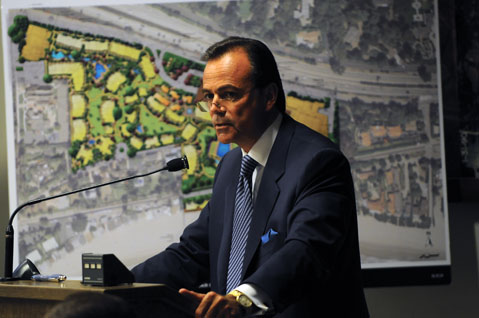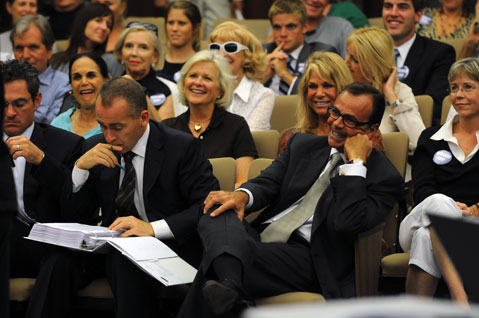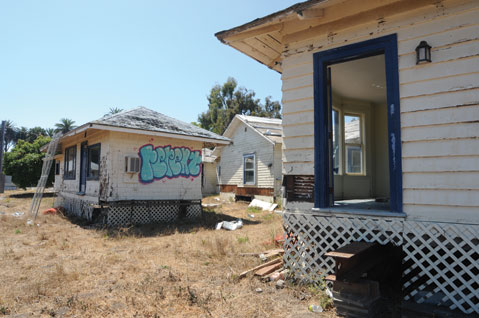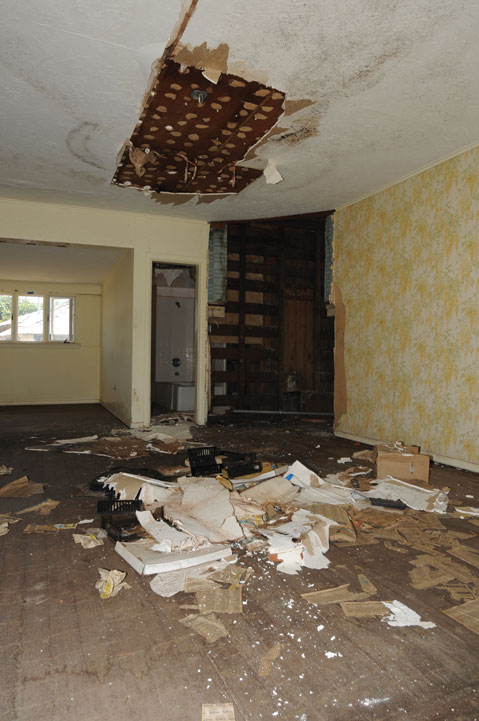Trading Miramar Bed Tax for Buildings
New Plan in Los Angeles Developer Rick Caruso's Plight to Rebuild the Historic Hotel

Rick Caruso is a busy guy.
Until his deal fell through last week, Caruso was on the short list of people trying to purchase the Los Angeles Dodgers for something like $1.5 billion. He’s considering a run to be mayor of L.A. next year, and even if not, he’s known to spend hundreds of thousands — sometimes millions — on others during election season every year. His Americana at Brand and Grove shopping centers are two of the snazziest in Southern California, and he’s also gambling on Las Vegas, where he’s the exclusive leasing agent for a new $550-million retail, entertainment, and food district being planned by Caesars for the middle of The Strip.
That busy schedule, however, is bringing lots of frustration to Santa Barbara, where people wonder what’s taking the well-coiffed, well-dressed, and, well, well-done-everything-else Caruso so long to rebuild the historic Miramar Hotel on the Montecito coast. When the developer — whose personal fortune is estimated to be $850 million — first got involved nearly five years ago, he promised that if he couldn’t get a bank to finance the roughly $170 million project, he’d do it himself. “Banks are calling us,” Caruso told The Santa Barbara Independent in 2007. “We have a balance sheet that, if it came down to it, we could do it on our own.”

But by the time his five-star, 186-room project was approved for the 16-acre South Jameson Lane property a year-and-a-half later in December 2008 — just three months after the now notorious collapse of Lehman Brothers — the world would be in the midst of a recession. Amid foreclosures, bankruptcies, and layoffs, the market for constructing luxury hotels tanked. “It’s not an outlier,” explained Matt Middlebrook, a senior vice president with Caruso Affiliated, of the Miramar, which has sat vacant and been bumped from hotelier to hotelier since 2000. “It’s the norm.”
Those once-eager banks are just now starting to call again, and Caruso — despite the lingering intrigue and mistrust that he’s endured since the first Montecito Association meeting in 2007 — remains unyielding. When I spoke to him on his cell phone last Friday, the ever-polite Caruso only had a minute to talk, yet he did so matter-of-factly, explaining that he’s always intended and still intends to rebuild the Miramar himself.
Caruso’s next big idea will be entertained by the County of Santa Barbara’s Board of Supervisors on Tuesday, when they’ll decide whether to take the next step in a proposal to wave off a decade of potential bed taxes and extend his soon-to-expire building permits forever in exchange for the immediate demolition of the unsightly, dilapidated, and trouble-attracting blue-and-white structures on site. Though most publicly agree that cleaning up the 12-year-old mess is a pretty attractive trade-off, others quietly surmise that the deal’s estimated $18 million in tax savings — which amounts to chump change for this near-billionaire — is more likely a way for Caruso to dump his long-struggling property to the next highest bidder.
Caruso flatly denied those allegations during our brief conversation on Friday afternoon. “I have no interest in selling — I’ve been approached by a lot of people trying to buy, and we’ve turned them down,” he told me. “I have no reason to lie to you. There’s no hidden agenda here.”

The Plan
Two parts of Caruso’s proposal are straightforward. The county supervisors are almost certain to extend the permits — which expire in mid March — by a year. They rarely deny such a request, and in this case, no one wants to be on the political hook for making this beleaguered process start all over again. That would likely doom the project for another decade or so.
And knocking down the crumbling structures is something that everyone had been pleading for since at least 2007. The only confusion here is why the county has not condemned the buildings and forced Caruso to tear them down already. It turns out that they can’t, according to county CEO Chandra Wallar, as the structures, while ugly, have not been declared a danger to the greater public, so the building code’s condemnation policy does not apply. But Caruso says he would do it himself if his plan is approved Tuesday, shouldering the expected $1.5 million in demo costs and beginning teardowns as soon as possible, after getting the right approvals and paying another $1.5 million or so in fees to the California Coastal Commission for a permit.
The third aspect of the plan — the 10-year bed-tax rebate — is what has everyone buzzing. Currently, everyone who stays in a hotel in the unincorporated parts of Santa Barbara County pays a 10-percent transient occupancy tax (TOT, otherwise known as “bed tax”), so a $200 room at a Los Olivos bed-and-breakfast gets bumped to $220. In the last fiscal year, those taxes brought in $6.9 million to the county.
But Caruso wants a 10-year break from the TOT once the Miramar is in operation. So on Tuesday, the county supervisors must determine whether it’s worth leaving potential money on the table — which is estimated to start at about $1.5 million per year and range up to $2.1 million by the end of that decade — in exchange for a stronger hope that the Miramar actually gets built and begins to generate property and sales taxes that go beyond what the bed tax would have delivered.
And it’s not just for the Miramar. Because of where the hotel project is in the development process, Caruso’s proposal would have to take the form of a countywide ordinance: If the supervisors decide to move forward and ultimately approve it, anyone building a new hotel in the unincorporated part of the county would be able to apply for a similar rebate. Those applications would then go to the Board of Supervisors for approval. If given the okay, a hotel developer would have up to four years to finish building the project before the 10-year rebate period began. So if this ordinance is approved, and it takes Caruso five years to build the Miramar, then he’ll only have nine years of rebate; if it takes eight years, then he’d have only six years, and so on. Procedurally, the hotel would still charge visitors with the tax, submit the funds to the county, and then be rebated the money on the back end. Though creative, Caruso’s proposal is not novel, as it already exists in Los Angeles, Anaheim, Palm Springs, and elsewhere.

The Numbers
As it stands, the Miramar property — which was assessed at $54.9 million even while vacant — is taxed by the county at $568,000 per year, and that gets divvied up by 16 agencies, with about $142,000 coming straight to the county’s general fund. If the hotel finally gets developed, the county’s number-one number cruncher, Bob Geis, estimates that the property tax would bump to $1.7 million per year and that sales taxes would generate an additional $1.5 million.
Which is to say that, even without the TOT revenues, there’d be more money flowing into the county’s back pocket once the Miramar is built. The same is true for the Montecito Fire District, which would get an extra $176,000 a year, and Montecito schools, which would double their revenue off of the Miramar to bring in almost $1 million annually.
“Today we get minimal property tax, we get no sales tax, and we get no TOT,” said Geis, whose office provided a preliminary analysis to officials last week. “It seems to be worth the economic incentive to give them a rebate.”
And, as Caruso’s VP Middlebrook is quick to point out, that also doesn’t count the approximately 1,000 construction and trade jobs that will contribute to building the resort or the $10-million payroll that Caruso has pledged to employ.

The Naysaying
But not everyone sees this light, especially because — according to county staff emails obtained by The Santa Barbara Independent — getting the TOT was one of the main reasons that former county CEO Mike Brown wanted to fast-track the project. During a meeting last week, Montecito Planning Commissioner Claire Gottsdanker summarized what many have been saying in private: “It is very shortsighted just to get the buildings down.”
The proposal is most troubling to existing hotel owners who will one day be competing with the Miramar for customers and see this decade of significant rebates as unfair to competition. “Allowing this operator to shirk his fair share does not make financial sense for a county that is struggling financially, and it sets a precedent for all future developers to ask for tax forgiveness,” wrote Paul Bullock to the county supervisors last week in his role as president of the Greater Santa Barbara Lodging and Restaurant Association. “We say keep the playing field level and keep the rules the same for all hotel operators — existing and proposed.”
But the county’s CEO Chandra Wallar believes that a strong Miramar could possibly help the hotel market at large, explaining, “The launching of a new luxury hotel is typically associated with a large marketing effort that will emphasize the attractiveness of the destination, such as Santa Barbara, in addition to the specific hotel.” Or, as Middlebrook said, “A rising tide lifts all boats.”
Yes Men
After 12 years of vacancy and dilapidation — including the past four during a recession — any step toward reopening the Miramar, bringing back jobs, and generating any form of tax revenue manages to spark excitement. The Santa Barbara County Taxpayers Association voted unanimously to support the program, and the Montecito Association, while not weighing in directly on the TOT rebate, said it supports the efforts by Caruso and the county to “find terms that are fair and equitable to all concerned that would result in the final cleanup of the Miramar site.”

Sitting in the middle of it all is 1st District Supervisor Salud Carbajal, whose district is home to the Miramar and generates, via Montecito mansions, the highest property taxes in Santa Barbara County. Though he’s a politician with a knack for bringing all sides together, Carbajal — whose political war chest received $15,000 in donations from Caruso’s camp in 2011 — is between a rock and a hard place with this issue. If he votes to give Caruso the entitlements based on promises of development, and then Caruso offloads the property to someone else, Carbajal will look like he’s been played. But if the supervisor takes a stand and says no, then the property will sit vacant for years to come, and Carbajal will probably look even worse.
Last week, Carbajal said he has two objectives: demolish the buildings and develop the property. “There’s good arguments from all sides,” said Carbajal, who said he had not made up his mind yet on whether the loss of bed tax was outweighed by the demo and hopeful increase in property and sales taxes. “In this arrangement, is half a loaf better than no loaf?”
Is Rick Ready?
When it comes to breaking ground, the real question is whether this deal makes developing the resort any more worthwhile for Caruso, who expects to drop an initial $68 million of his own money on the $170-million project. Plus, it appears he hasn’t paid back all of the $50 million he borrowed to purchase the property; though initially loaned from a bank, those IOUs are now owed to the same investors behind La Entrada, another anxiety-causing, undeveloped hole in the ground.

County analysts think the Miramar project could reasonably generate between $8 million and $12 million annually after expenses, but that’s considered a “low return for a project of this magnitude and risk.” And luxury projects haven’t been so luxurious in recent years: Look at the Bacara, which sold for $15 million below its assessed value and half of what it cost to build, or San Ysidro Ranch, which was reportedly only at 30-percent occupancy last year, or the Biltmore, which was reportedly at a similar occupancy last month.
But if his fat wallet and overloaded calendar are evidence of anything, it’s that Caruso is a smart businessman. He wasn’t going to buy the Dodgers without the Dodger Stadium parking lot, and he’s not going to buy a hotel he doesn’t think can stand on its own and make money.
“I look forward to building this hotel,” said Caruso. “Hopefully we’ll get that started soon.”



